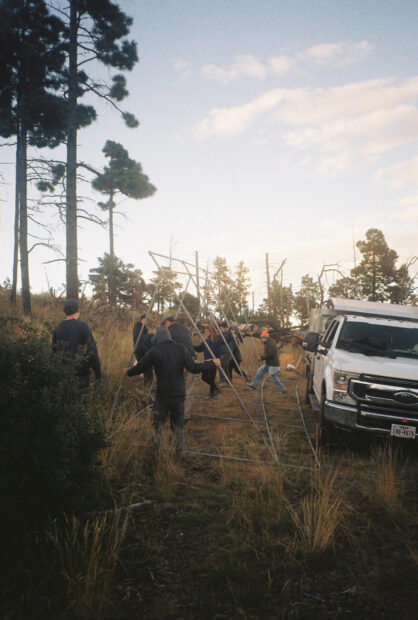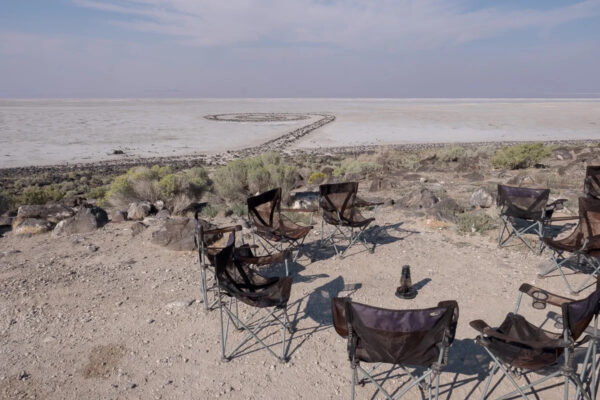Para leer este artículo en español, por favor vaya aquí. To read this article in Spanish, please go here.
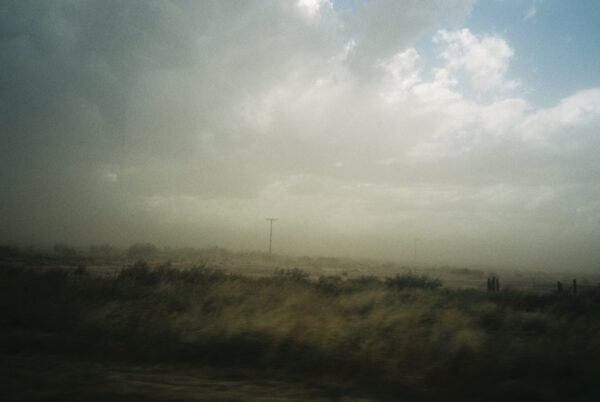
A dust storm as seen from the road to Chiricahua Mountains, Arizona. Photo by Megan Mckenzie (2022).
September 20, 2022, was a clear, quiet night at Double Negative — no clouds or people but the Land Arts of the American West cohort. We were there one night, so we cooked pasta in the open air and ate under Cassiopeia and Perseus. The still night asked for stillness in return, but we interrupted it with laughter and dancing. Fifty years earlier, two cowboys in Nevada might have had a harder time disobeying the decorum demanded by the desert, should it not have been for another intervention.
September-October 1971: Dave Hickey’s “Earthscapes, Landworks, and Oz” is published in Art in America, starting with the axiom that “a strict decorum governs conversation between man and man in hard climates and desolate country.” But he sees an exception to these hard climates and strict decorums, which he illustrates with an anecdote about his cowboy father-in-law. Hickey reminds us that in the country, conversation requires Men to address “themselves to some external object or phenomenon with an attention which amazes outlanders. They do not know that those two men standing on the concrete apron of the Mobil station, staring down the highway toward a fragile wisp of cloud, may, while discussing that cloud, reveal their souls, and only discover as much of one another as they want.”
Staying true to tropes of western masculinity, Hickey and his father-in-law are only able to relate to one another in front of an external object that mediates their conversation. This external object might be a floating cloud, or it might be the all-too-familiar experience of standing in a clean, well-lighted space, but Hickey conjures up the memory to talk about the movement in the 1970s towards Land Art. For Hickey, interventions in the landscape occasion people to reveal themselves; replace the cloud with something more permanent, like Michael Heizer’s Double Negative (1969), and Hickey and his father-in-law might be able to have a particularly eloquent conversation.
Like us, Hickey grew up in Texas and went to the University of Texas at Austin. And like us, he was probably raised with the elementary school maxim that Texas is so big that fifteen smaller states could fit snugly inside its borders. Those who have spent significant time in the Lone Star State™ usually share a paradoxical configuration of space — that land is infinite just as much as it is fragmented (maybe even into fifteen smaller chunks).
As such, Hickey’s description of the American West as “really too big for human beings” resonates deeply. One must do mental gymnastics to make sense of a space the size of Texas, either by projecting minds and bodies outwards, or by conceiving of the landscape in what Hickey calls “man-sized chunks.” The physical and mental division of land into digestible sections mediates our relationship to the world, making it a little more comprehensible. And as with the two cowboys and their cloud, these sections also negotiate our relationship to one another. Hickey frames these “man-sized chunks” as major works of Land Art, but the analogy draws far beyond that — and Chris Taylor would agree.
Taylor is the director of the Land Arts of the American West field program at Texas Tech University. If you’ve met him, you remember him. He is a firm advocate that land art can and should encompass much more than the iconic works by Heizer, Holt, De Maria, and Smithson. At the very least, he knows that landscapes not framed as these works should be considered with equal weight, and equal attention.
Since 2002, Taylor has led students across the Southwest to talk about land use, land restitution, and critical ecology, as well as Land Art in the more traditional sense. The three-month field session travels throughout Utah, Nevada, Arizona, New Mexico, and Texas to camp at a diverse set of land formations and cultural sites. Every year, a group of artists, writers, and architects commit to spending ninety days bound to one another. Most are strangers at the start, though the possibility of remaining such is next to none. Excluding the two of us, the 2022 cohort is composed of six talented, generous, and thoughtful individuals to whom our experience is indebted — Megan Mckenzie, Emily Lee, Miranda Klein, Walker Guinnee, Elise Coleman, and Ty Cary — and our brilliant program assistant Talia Brown. For the Land Arts 2022 cohort, “man-sized chunks” became a colloquialism for any land formation or intervention — from mountains to litter — that mustered a conversation.
Our first site was Cebolla Canyon, New Mexico. After sheepishly introducing ourselves to one another during the eight hour drive, we arrived at our campsite as dusk was rapidly approaching. The air smelled like pine and canyon, whatever that means, and the hill we would inhabit for three long days stood staring at us. With no time to spare, the group swung into quick, blind motion to build “the structure.” It was a word we had no referent for at the time, but the structure would soon become the centerfold of our lives.
Against the backdrop of a looming sunset, Chris and Talia passed metal poles to their protégés, who formed a foundation of four bays. We built it from the ground up, working in tandem to raise walls and bind tarps into a “ceiling.” We were probably all in awe of the structure that first night — it at least sounded like it as we clapped and cheered (something we often did through the season). The structure was constructed thirteen more times after that, sometimes smoother than others. Talia called the whole endeavor our Choreography of Repair, and it really was a choreography.
These romantic musings are all to say that our metal structure was our first “man-sized chunk.” If Hickey’s cloud counts, why not our structure? The structure was a hearth, and we found ourselves naming it as such. If we strayed from camp, we caught ourselves saying we wanted to “go home.” The structure was shade and shelter. We shared meals under it every morning and night, and watched movies on the tarp-turned-screen. And if we wandered too far in any one direction, the structure was a beacon. It was a frame metaphorically as well as literally, a way to talk about our place in the land.
Returning to the kind of chunks Hickey’s essay is most concerned with, we spent three days with Robert Smithson’s Spiral Jetty (1970). Upon arrival, Spiral Jetty was enveloped in white smog from wildfires miles away. The haze was so thick that ground and sky were confused, leaving the work bare on a dry sand bed with no Salt Lake in sight. In fact, the shoreline was a fifteen-minute walk away if your pace was steady. All of us had seen those aerial photographs of the earthwork against characteristically pink waters prior to embarking on the field program, but the jetty in front of us was nearly unrecognizable.
As much as the group had been prepared to talk about Robert Smithson and histories of Land Art at the Spiral Jetty, we found ourselves more invested in conversations about the lake’s dangerous salinization levels, the receding shoreline, and the very real potential of arsenic dust blowing across Utah should the lake continue to dry up. Spiral Jetty became a barometer for measuring the environment changing around it. It was a tool to talk about the local, and ask what the realities of the Great Salt Lake in front of us could tell us about other places.
Hickey tells us that his “man-sized chunks” are most useful for mediating conversations that are difficult to conjure otherwise. For him and his cowboy father-in-law, this conversation was about feelings, which for them existed only in the abstract. For us, conversations centered around things we too found abstract or difficult to fully conceptualize: borders, water-use, nuclear testing, invisible violence, and repatriation, among other things.
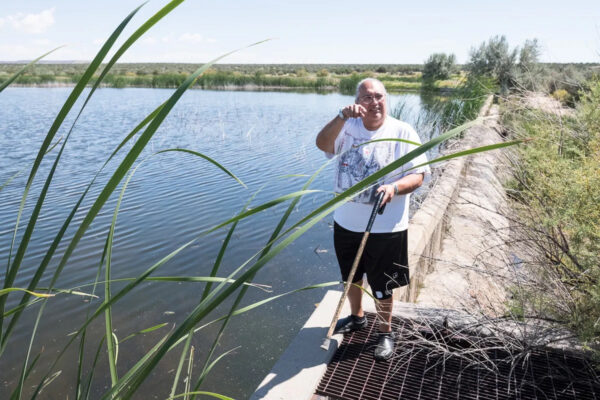
Curtis Francisco on Mesita Dam, which used to impound agricultural water and now impounds radioactive water downstream of the Jackpile Mine Site, Laguna Pueblo. Photo by Chris Taylor (2022).
On September 2 we traveled to the Jackpile Mine within Laguna Pueblo, where we met geologist and Laguna tribal member Curtis Francisco. Over a generous lunch prepared by him and his family, we learned about one of the largest open-pit uranium mines in the world and its devastating impacts on the Laguna people. Jackpile Mine began operations in 1953, before regulations existed to protect against gamma radiation, radionuclides, and uranium contamination. According to Francisco, the tribe was given two options: either let the mine be built, or refuse and watch the land be exploited anyways.
Today, there are no protections for the community forced to live with the aftermath of toxic extraction. The land affected by Jackpile is largely unusable for agriculture, though many still use the area for cattle ranching, with nowhere else to go. In “Through the Jackpile-Paguate uranium mine” (2020), Francisco describes growing up in the Laguna Community, sentiments he echoed in his conversation with us:
We lived with the dust-enveloped mine. We lived with a wasteland of radioactive devastation. We now live with a partially remediated ruin, which continues to affect our groundwater, our surface water, our soil, our soul.
After lunch, we followed Francisco to the site itself. We gathered around a small reservoir, which he knew to be contaminated by uranium run-off; without him there, we would have never known. Standing dangerously close to the edge of the undetectably radioactive pool, Francisco told the story of another contaminated body of water, which he recounts in the same text:
Up in the mine, there used to be a lake; a beautiful, turquoise-blue lake. There was no life in it at all, no algae, no fish, no plants around it, no mosquitos, no insects, no birds. You wouldn’t even see waterfowl around it… Grandpa spoke of the turquoise lake in terms of death. It was called Shu-mu Gu-ywei-tro. The precise translation of this Keresan toponym is ‘this is where death lives.’ ‘This is death’s home.’ It looked beautiful, but it was deadly. Death is not someone you want to affiliate with.
Before uranium was ever found by scientists, the Laguna people knew to avoid the lake by observing the land and listening to stories from tribal elders. After receiving his B.S. in Geology from New Mexico State University, and working for the Environmental Protection Agency, Francisco returned to gather proof that the groundwater at Laguna Pueblo was contaminated by uranium. The mine was finally listed as a Superfund site in 2017, though efforts toward remediation have been slow. Even today, there are no signs marking radioactive areas.
The reservoir we were in front of, and the lake Francisco recounted, provided a concrete image of what too easily remains “invisible.” The lake was, for us, another “man-sized chunk.” It gave physical form to the realities of uranium mining, nuclear waste, and environmental racism, all of which again too easily slip into the realm of abstraction. As we said our goodbyes and thank you’s, Francisco reiterated that he just wanted people to know “this was here” — to acknowledge Jackpile Mine’s existence, as well as its continued aftermath for the Indigenous people who have lived there for thousands of years, and everyone downstream along the Rio Puerco and Rio Grande.
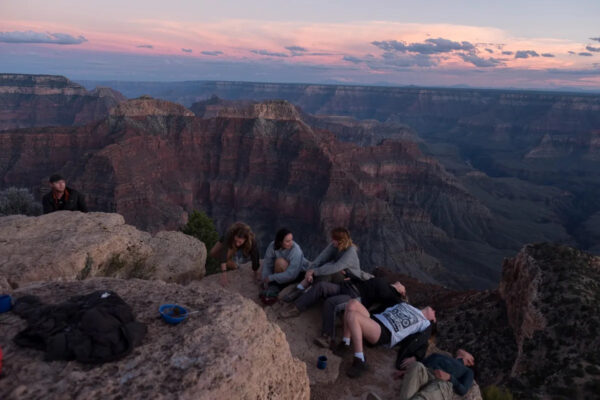
Light Lingering at Point Sublime on the North Rim of the Grand Canyon, Arizona. Photo by Chris Taylor (2022).
From our time in the field, we can name many more man-sized chunks we used to understand our relationships to one another, the landscapes at hand, and the world. Some include the hoodoo at Goblin Valley that Talia named “the Lover’s Rock,” the corner of Point Sublime where we ate spaghetti, and the van that moved us from chunk to chunk, though the list goes on.
The purpose of remobilizing Hickey’s notion of man-sized chunks is not to extend the complicated label of Land Art to all land formations, man-made and otherwise. Rather, it is to suggest that the mode of seeing required by Land Art — one of intentional, durational, attentive looking at the landscape — can and should be opened up to all things going on in the land, from natural topographies to human interventions. This is perhaps especially true of Texas, where desert terrains are too easily imagined as empty, homogeneous, and inhospitable. Afterall, it is “really too big for human beings.”
That Land Art sites like the Spiral Jetty have prompted so many to sit in front of (or in the distance of) the Great Salt Lake with mindfulness and care is no small matter. But let us grant that gift of consideration to other landscapes, too. The way of seeing we extrapolate from Hickey’s man-sized chunks finds kinship in Taylor’s call for close looking and Francisco’s reminder that violence rendered invisible to the eye becomes apparent through observation and duration. Maybe these analogies can be our training wheels as we broaden the scope of land we consider deserving of attention, resources, and responsibility.
**********
Bibliography
Hickey, Dave. “Earthscapes, Landworks, and Oz,” Art in America (September – October 1971).
Francisco, Curtis. Whitmore, Christopher. “Through the Jackpile-Paguate uranium mine” in After Discourse: Things, Affects, Ethics. Routledge Archaeologies of the Contemporary World ser. Taylor & Francis Group, 2020.
Taylor, Chris. “Once mountain, now pit, pile, pipe,” The Brooklyn Rail (June 2022).


